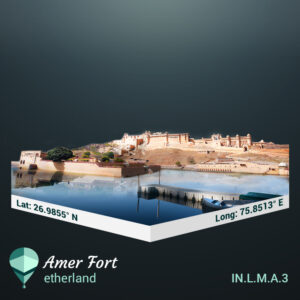 Sometimes referred to as Amer Fort, this historic hill fort rises above the town of Amer. Founded by the Meena in 967, the fort has grown over the centuries, mainly under the reigns of Raja Man Singh in the 16th century and Jai Singh I, his descendant. The palace enclosed in the fort is one of the most popular tourist attractions in the state of Rajasthan.
Sometimes referred to as Amer Fort, this historic hill fort rises above the town of Amer. Founded by the Meena in 967, the fort has grown over the centuries, mainly under the reigns of Raja Man Singh in the 16th century and Jai Singh I, his descendant. The palace enclosed in the fort is one of the most popular tourist attractions in the state of Rajasthan.
India is one of the oldest civilizations known to the world. This fact makes modern India a land rich in history, culture, tradition, and architecture. Located some 11 km away from Jaipur, the state capital of Rajasthan, the city of Amer is no exception. Being mainly known for its eponymous Amer Palace, Amer ka Qila or Amer Fort, the city houses several other impressive landmarks.
At first, only a settlement founded by Raja Alan Singh in the late 10th century, the Amer town quickly grew in size and importance as the Kachwahas Rajas made it their capital in 1036. Located on the Rajasthani Hill of the Eagle (Cheel ka Teela), the fort we know today was constructed by Raja Man Singh in the late 16th century and fully expanded by Jai Singh I. The nearby Jaigarh Fort is often considered an extension of the Amer Palace, as an underground passage connects the two. It allowed the Rajas’ family to escape to the better-protected Jaigarh Fort in times of war.
Overlooking the Moata lake, the Amer Fort attracts visitors for its Mughal and Rajasthani-styled architecture, large ramparts, majestic gates, and maze-like passages of cobblestones. The structure was built in marble and red sandstone, adding to the wonder of the fort. The inside of the fort is divided into four courtyards.
The main, first courtyard is approached through the Sun Gate (Suraj Pol), the famous Jaleb Chowk. Armies used this gathering place for the celebration of their victories and parades. Next to the Jaleb Chowk is a small and beautifully decorated Sila Devi temple from the early 17th century. This site of worship and ritual sacrifices is shut by a magnificent silver door covered in raised reliefs depicting Hindu deities. Inside the temple, there is a carving of Hindu Lord Ganesha built from a single piece of coral. Ending the first courtyard is the Ganesh Pol, a magnificent gate orned with frescoes, marking the entry to the Rajput Maharajas’ private palaces and third courtyard.
An intricate stairway from the first courtyard leads to the second courtyard. This section of the fort consists of a vast public audience hall, Diwan-i-Aam. This hall is open from three sides with a raised platform raised by the support of 27 pillars with elephant-shaped carvings. The extensive delicate glasswork at the ceiling is a sight that blesses the eyes of visitors. The public used to gather here to talk to the Raja during audiences.
After entering the third courtyard through Ganesh Gate, visitors can enter the Jai Mandir from the left of the Mughal-styled garden. It harbors a magnificent ceiling built with glass inlaid panels and a multitude of mirrors covered in colored foils, flickering inside the temple under candlelight. This added attraction is often known as the Mirror Palace or Sheesh Mahal. On the opposite side of the garden is the Sukh Mahal, made in sandalwood and ivory. Inside the structure of the Sukh Mahal runs a complex piped water system meant to keep the temperature pleasant in the living spaces, reminding air conditioning principles. Another major attraction in the third courtyard is an elegant marble panel carving known as the magic flower.
The final courtyard was made for women of the Palace, including queens, princesses, and concubines. This part of the Palace has living rooms accessible from a common corridor and a hall known as Jas Mandir used for private gatherings. At the southern end of the courtyard sits Man Singh I’s Palace. Built over 25 years and completed in 1599, it served as the private residence of Maharaja Man Singh I, where he would meet with his queens.
For its rich culture and history, the fort was declared a UNESCO World Heritage Site in 2013. Welcoming over 1.8 million visitors per year, Amer Fort is a treat to history and architecture lovers alike and certainly one of India’s greatest wonders.